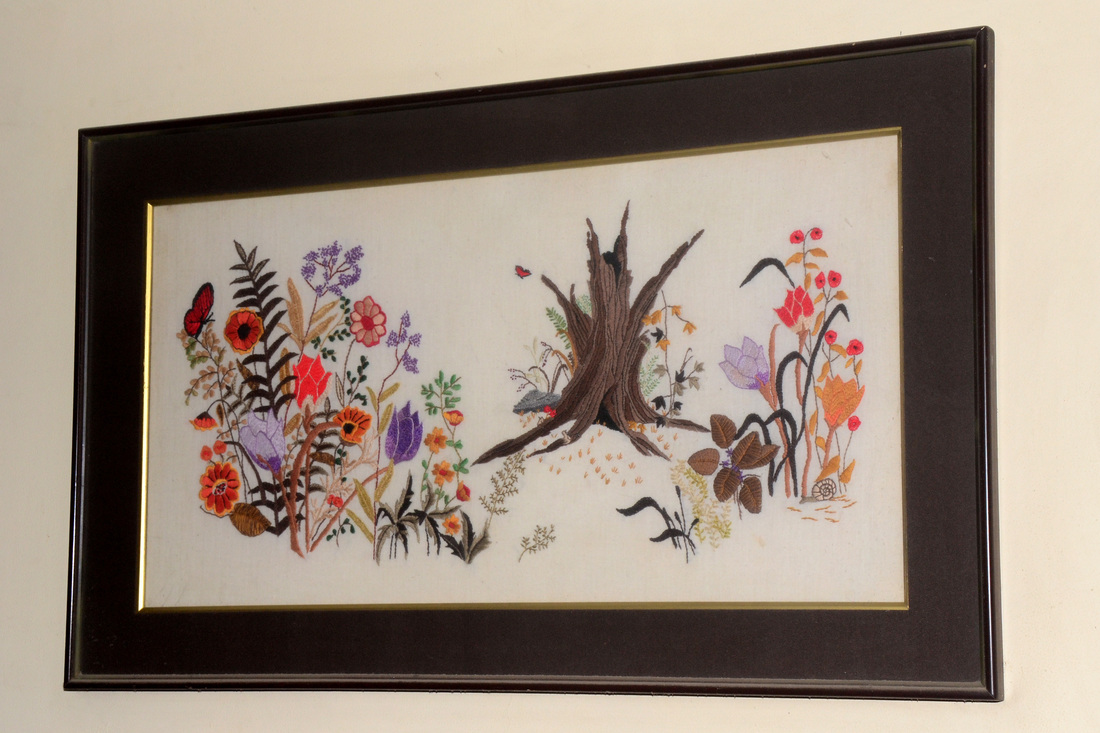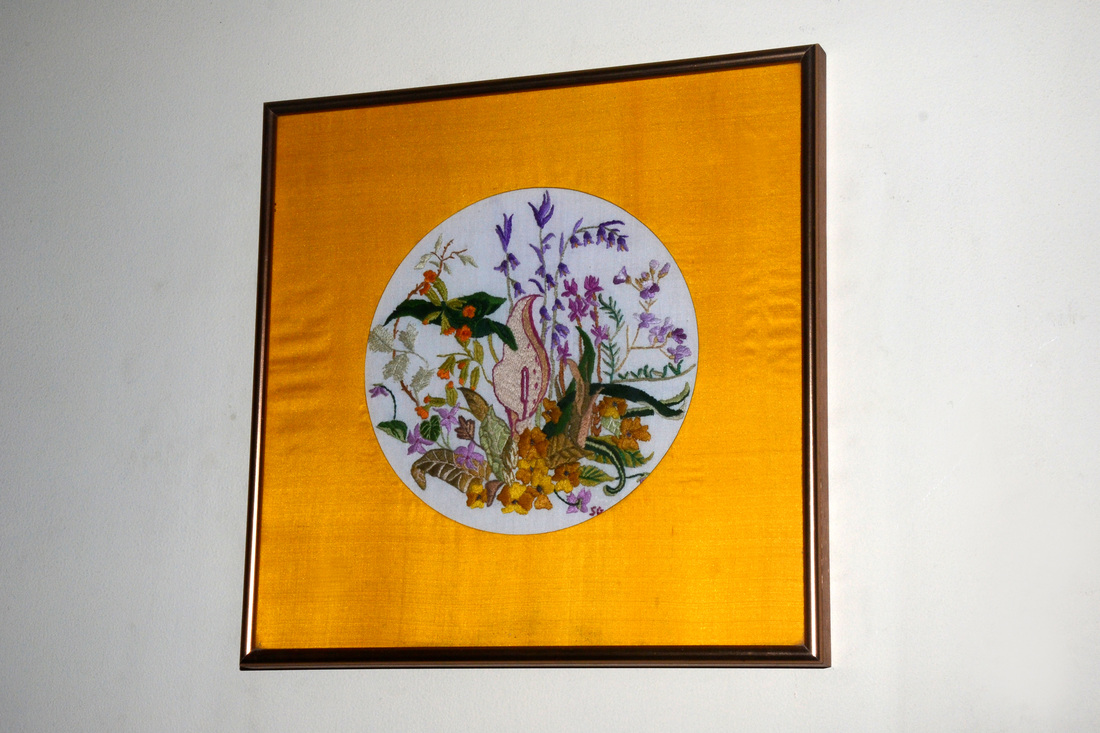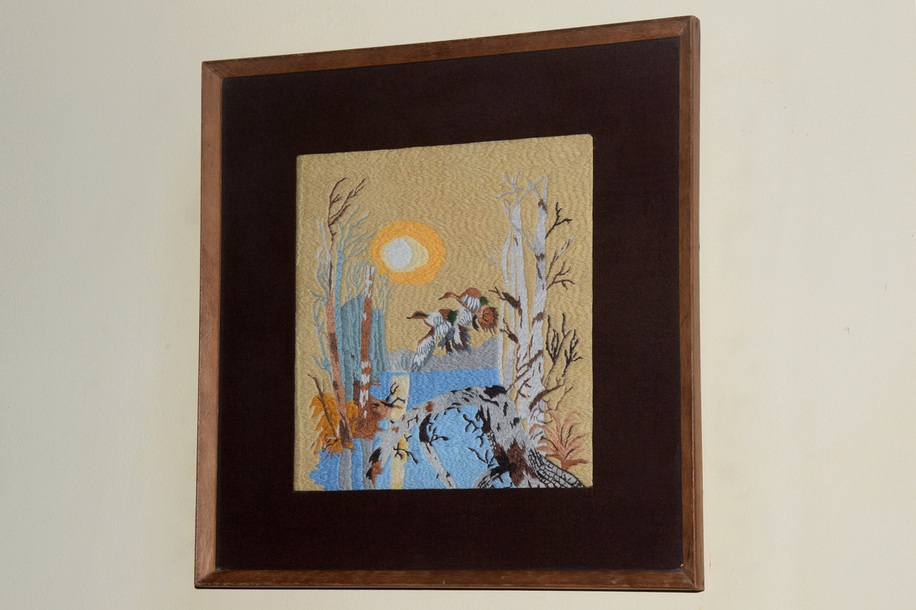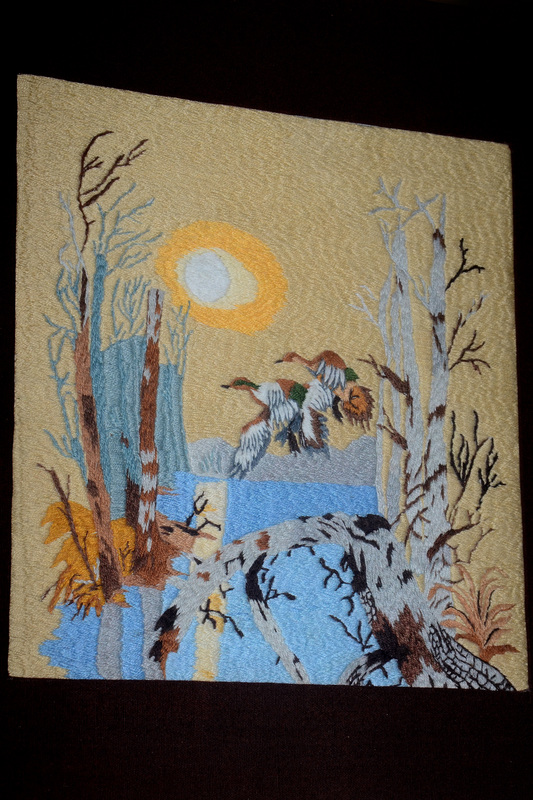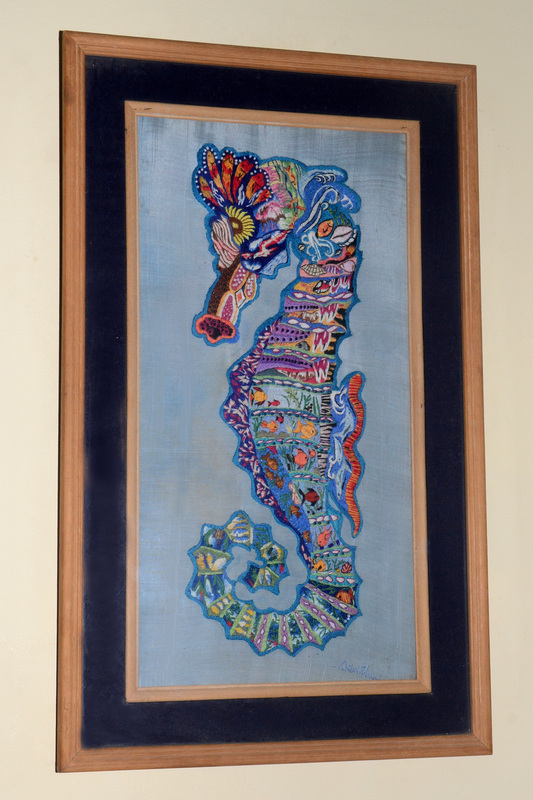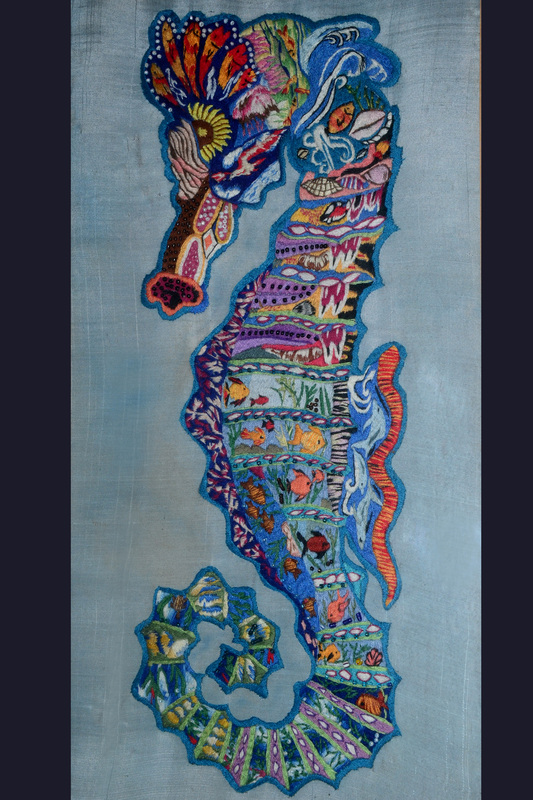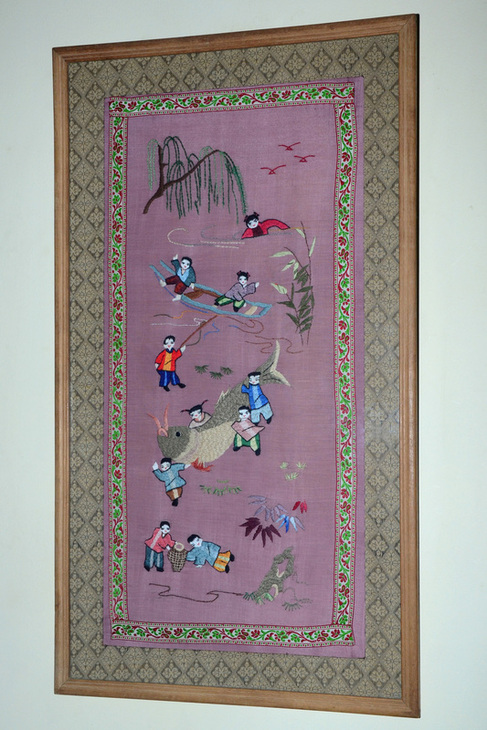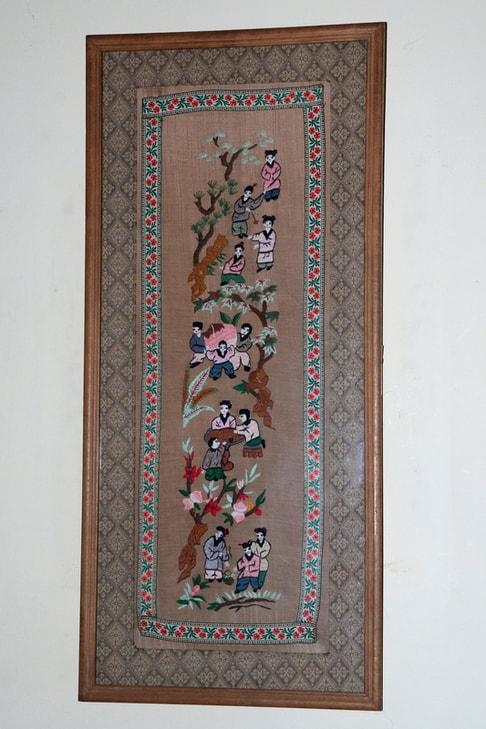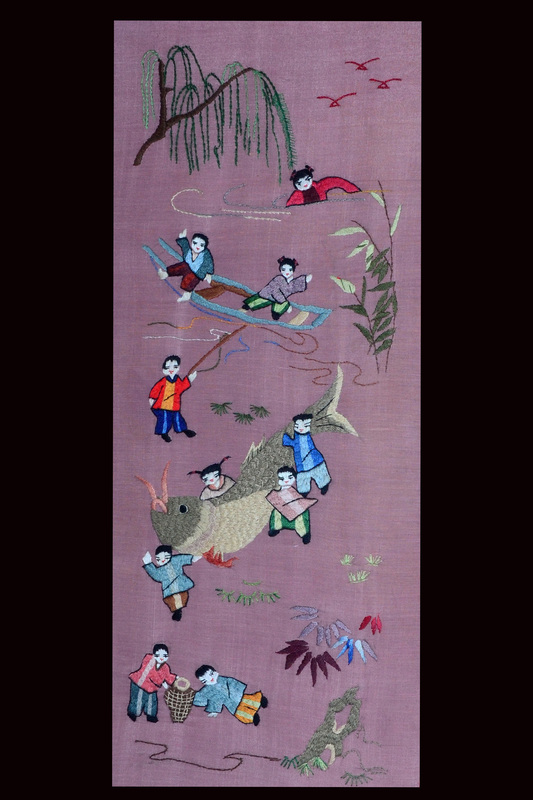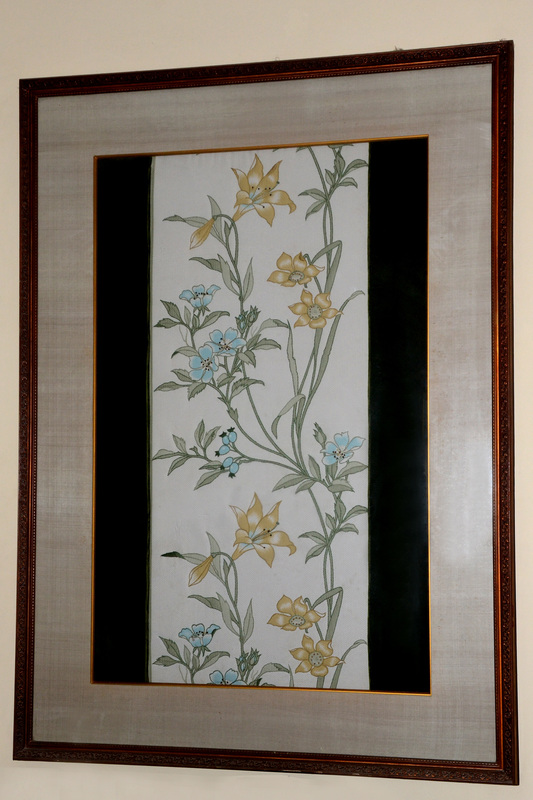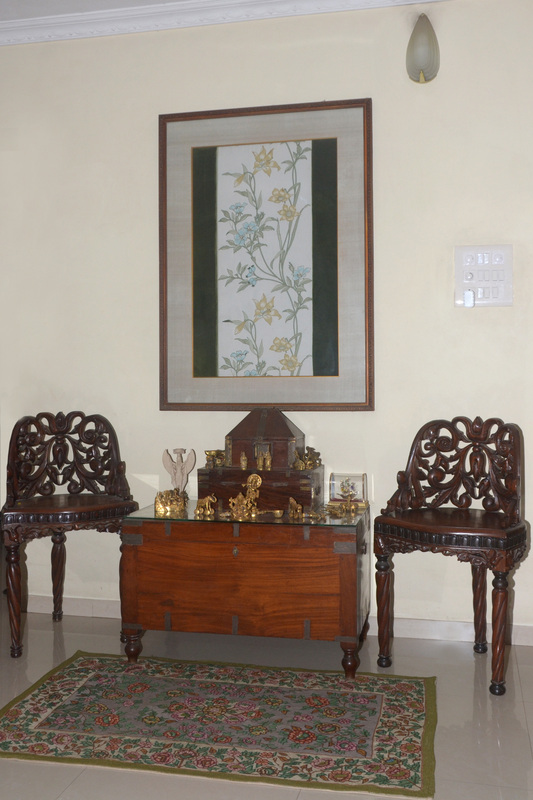PAINTING WITH THREADS
Embroidery is one of the most serene, yet absorbing occupations I know of. It is an intense and solitary pastime, but watching a picture come alive, stitch by stitch, as your needle weaves in and out of a piece of fabric, is a magical experience. My mother is a very skilled needlewoman, and when I was a little girl, she always seemed to be working on pieces of embroidery. I would watch her carefully, and sometimes, when she would put down her embroidery frame for a few minutes to attend to something else, I would quickly pick up the frame and try to do a few stitches myself. But to my surprise and disappointment, though I felt that I was copying her perfectly, the stitches I sewed were always crooked and untidy. My mother would click her tongue in dismay when she saw my stitches, and quickly unpick my work. When I was about ten years old, I nagged my mother to let me do some embroidery on my own. This first project was a little green tablecloth, which had small bunches of orange flowers embroidered in each of the corners. The stitches used were simple chain stitch and lazy daisy stitch. I was quite proud when the tablecloth was finally complete, but I remember wondering in some dissatisfaction, why the stitches in my work did not look like the neat ones, of the same size, that flowed so effortlessly from my mother’s needle! When I was fourteen, I visited the home of a grand - aunt in Kerala, Mrs. Narayani Menon, who was a champion embroiderer. I was captivated by the beautiful pictures that she had made, by filling fabric with tiny, extremely neat stitches of many different kinds. She showed me a parrot she had embroidered for her little grandson – unusually; it appeared slightly untidy in the centre. When I asked my grand-aunt curiously about this, she told me ruefully that her cat had mauled it, believing it to be a real parrot! I was so captivated by this charming story, and my grand aunt’s wonderful needlework that I decided then and there that someday, I too would do similar, fine embroidery. By the time I got married at 20, I was a fairly competent needlewoman, and had developed the patience, perseverance, and discipline that are a must if you need to do detailed and intricate embroidery.
None of the pictures that I have embroidered over the years are patterns taken from embroidery books – they are images that have caught my eye over the years, and come from sources as varied as greeting cards, pictures from paintings and calendars, and even porcelain plates. (This was of course before the age of the Internet, when resourcefulness and creativity was not available at the click of a mouse!) One of my embroidered pictures is even taken from a catalogue for jigsaw puzzles! I thoroughly enjoyed creating my embroidered works of art, and they still give me immense pleasure. I embroider purely for my own pleasure, and my work, which is purely a hobby, has never been done commercially, and adorns my own home.
Embroidery is one of the most serene, yet absorbing occupations I know of. It is an intense and solitary pastime, but watching a picture come alive, stitch by stitch, as your needle weaves in and out of a piece of fabric, is a magical experience. My mother is a very skilled needlewoman, and when I was a little girl, she always seemed to be working on pieces of embroidery. I would watch her carefully, and sometimes, when she would put down her embroidery frame for a few minutes to attend to something else, I would quickly pick up the frame and try to do a few stitches myself. But to my surprise and disappointment, though I felt that I was copying her perfectly, the stitches I sewed were always crooked and untidy. My mother would click her tongue in dismay when she saw my stitches, and quickly unpick my work. When I was about ten years old, I nagged my mother to let me do some embroidery on my own. This first project was a little green tablecloth, which had small bunches of orange flowers embroidered in each of the corners. The stitches used were simple chain stitch and lazy daisy stitch. I was quite proud when the tablecloth was finally complete, but I remember wondering in some dissatisfaction, why the stitches in my work did not look like the neat ones, of the same size, that flowed so effortlessly from my mother’s needle! When I was fourteen, I visited the home of a grand - aunt in Kerala, Mrs. Narayani Menon, who was a champion embroiderer. I was captivated by the beautiful pictures that she had made, by filling fabric with tiny, extremely neat stitches of many different kinds. She showed me a parrot she had embroidered for her little grandson – unusually; it appeared slightly untidy in the centre. When I asked my grand-aunt curiously about this, she told me ruefully that her cat had mauled it, believing it to be a real parrot! I was so captivated by this charming story, and my grand aunt’s wonderful needlework that I decided then and there that someday, I too would do similar, fine embroidery. By the time I got married at 20, I was a fairly competent needlewoman, and had developed the patience, perseverance, and discipline that are a must if you need to do detailed and intricate embroidery.
None of the pictures that I have embroidered over the years are patterns taken from embroidery books – they are images that have caught my eye over the years, and come from sources as varied as greeting cards, pictures from paintings and calendars, and even porcelain plates. (This was of course before the age of the Internet, when resourcefulness and creativity was not available at the click of a mouse!) One of my embroidered pictures is even taken from a catalogue for jigsaw puzzles! I thoroughly enjoyed creating my embroidered works of art, and they still give me immense pleasure. I embroider purely for my own pleasure, and my work, which is purely a hobby, has never been done commercially, and adorns my own home.
The picture above is one of my earliest attempts at making an embroidered picture for my home. I found this beautiful picture of a colourful American forest floor scene in a copy of the British ‘Woman and Home’ magazine in the late 1980’s. The picture was part of an advertisement for a kit to sew the picture in crewel embroidery, using pure wool yarn. I was much taken by the picture because of its vibrant colours and small but interesting details like a squirrel sitting at the foot of the tree stump, a small snail half –hidden under one of the flowering plants, and butterflies hovering over the flowers. I enlarged the picture, and then embroidered it on thick, unbleached cotton using a variety of different stitches, in cotton skein thread. As every story-teller reinterprets, and changes a story a little when he or she tells it again, I too changed some parts of this picture. I used some different colours too in my work, but this embroidered picture which has hung in my home for over 25 years, has lost none of its charm.
In the winter of 1998, we got a New Year’s card with this image on it. I really liked this picture of pink peonies, bamboo, and two birds, painted in soft, delicate colours. The back of the card said that this lovely painting was an original painted by mouth and foot painting artist Wei-Der Chang, holding the brush in her feet. Embroidering a picture with threads is entirely different from creating one with paints. In embroidery, one is necessarily limited by the shades of threads available, and unlike as with paints, it is not possible to mix colours to create new shades. However, with a lot of experimenting, I think I did manage to capture the mood of this picture, in the exquisite style of traditional Chinese painting.
This work was inspired by a picture I saw in a magazine of a botanic print on a porcelain plate. I loved the way the flowers and plants in the picture were beautifully contained in a small circle, and was determined to embroider the picture. Of course, it is not possible, when working with threads, to capture the delicacy of the colours as they appear on fine, translucent porcelain. However, I was finally quite satisfied with my interpretation in thread of this work celebrating the glorious beauty of nature. I set off the picture by mounting it on a bright, canary yellow background. This sunny picture always cheers me up.
I saw this image (I'm not sure if it is a painting or a photograph) of a pair of Canada geese in flight on a New Year card that we got in 1991. I was so captivated by it that I just had to try my hand at reproducing it with my needle and thread! This composition which has mainly shades of brown, blue, and yellow, took about six months to complete. This thread painting is nearly a quarter of a century old, but still looks fresh and vibrant. Here's a close up image of the Canada geese in flight.
I usually work on light coloured backgrounds when I embroider pictures, but for a change, decided to try out a black background when I embroidered these flowers. The black background brought out the colours of the flowers and the green leaves perfectly, and this exquisite little picture in a round, teak wood frame has hung in different corners of the various homes I have lived in over the years.
The picture above is a smaller reproduction of a watercolour painting ‘Mountains in Spring Rain,’ (1995) by Japanese artist Masakichi Aoyama, that I found on a calender in the late 90’s. I liked this colourful painting, with its many layers and textures, celebrating the glories of springtime. When watercolours are used on paper and canvas, they have a translucent, almost ethereal effect that is obviously, impossible to capture with needle and thread. I worked with crewel needles of varying thickness to reproduce the different textures in this picture, and took around eight months to finish this work (there were spells of days inbetween when I did not touch my embroidery because of other commitments!) This needle and thread painting was mounted on plum coloured silk that I felt showed off the lovely colours of this composition very well.
I usually work only on cotton cloth, but when I embroidered the picture above, I worked on fine blue silk for the first time. I found this picture in a catalogue circulated on Delta Airlines in the early 1990’s – it was a seahorse shaped jigsaw puzzle of 600 pieces called ‘Horsin Around’ by the famous American artist Herb Schwartz. I was enchanted by the lovely scenes of life beneath the sea in each of the small sections of this gorgeous picture, and immediately set about trying to reproduce my own interpretation of this glorious image in thread. I used very fine needles, and single skein embroidery thread for this composition, and was quite satisfied with its final appearance – full of vibrant colour, yet calm and serene. This picture, more than 20 years old now, hangs in a corner of my dining room, and is a conversation starter. Here's a close up of the embroidered sea-horse.
The two embroidered paintings above are copies of traditional Chinese Hunan embroidery that I saw in a friend’s home and admired greatly. When her home was being painted, she kindly lent me these framed paintings. I looked at them very carefully, (using a magnifying glass to see better through the glass) then copied the designs, and embroidered them on pure silk as is always done with Chinese embroidery. Chinese Hunan embroideries usually portray scenes from the lives of Chinese children in ancient times, wearing traditional costumes. The pictures are lively and vivid, with amazing details. The posture and facial expressions on each of the figures are different, and are amazingly life-like. Hunan embroidery is a wonderful combination of ancient painting and traditional embroidery skills. In these pictures that I replicated, there are images that the Chinese like pomegranates, bamboo plants, and fish.
This picture, which I did 20 years ago, is a panel cut from synthetic curtain material that I saw in a store selling furnishing fabrics. I liked this design, and I outlined the flowers and the leaves in a slightly darker shade of silk embroidery thread first. Then, I filled in some of the petals of the flowers and leaves to highlight the delicate colours of the picture, and used small, brown wooden beads to emphasize the stamens of the flowers. I added bottle green velvet borders on both sides of the picture, before it was mounted on tussar silk, and framed. Most of the visitors to my home, who admire this simple picture (which is a little over four feet in height) find it hard to believe that this was once a bit of curtain fabric! I have teamed up this picture with antique heirloom furniture that I inherited, and this is the way it looks in my home.
The picture below was inspired by a painting by a famous American artist Patricia Buckley Moss, who is renowned for her portrayals of rural winter landscapes. The original painting was called 'Winter Royalty,' and I liked it because it captured the stark beauty of winter with just a few colours.
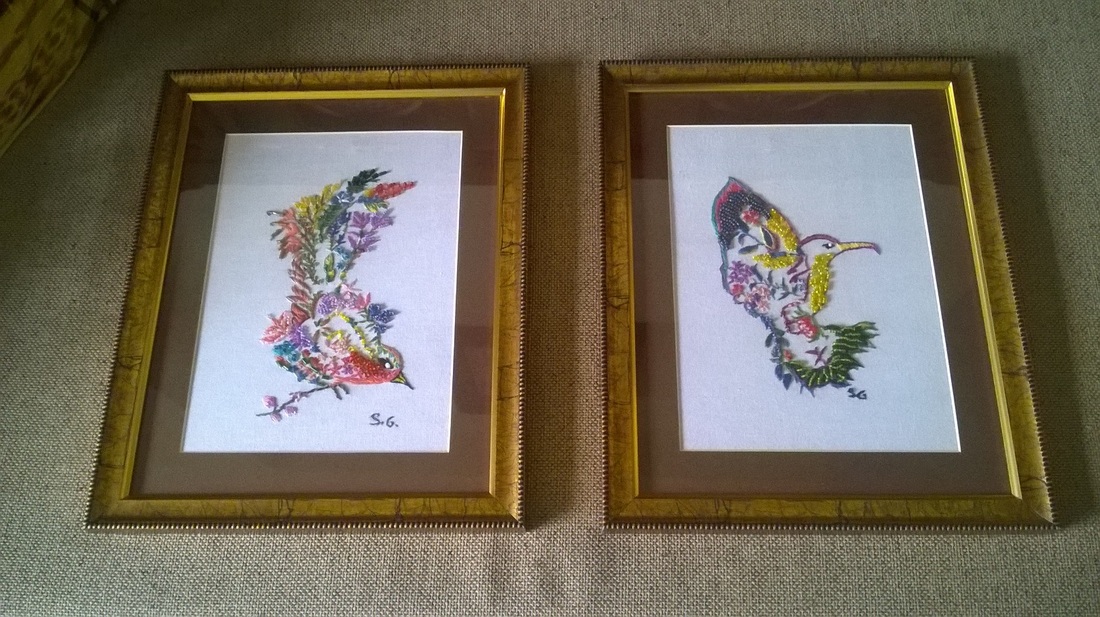
I found these two images of birds on a website - they were water colour paintings that I thought would look attractive if embroidered. I used up all the leftover silk embroidery skeins that I had in my sewing box, and added tiny crystal beads to the pictures.
Photography -V Santosh
Geeta Studio
09768405066/25585661
